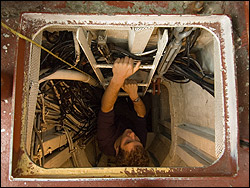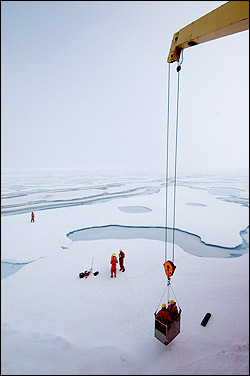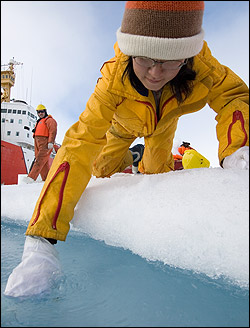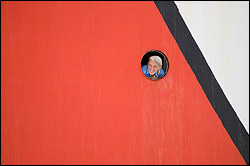Please note: You are viewing
the unstyled version of this website. Either your browser does not support CSS
(cascading style sheets) or it has been disabled. Skip
navigation.
Chris LinderAugust 20, 2005
This morning the fog parted enough for us to get a better view of the surroundings. Since we weren't breaking ice, First Officer Stephane Legualt led some tours up to the crow's nest, the highest point on the ship. To get there we climbed a cold ladder higher, higher, and higher still up inside the steel mast until we emerged on a small enclosed platform with windows on all sides. The most amazing part of the view was looking down into the smoke stack. The whole ship and surrounding ice was laid out before us. Stepane told us that observers used to be stationed up here to help find leads, or openings, in the ice. "I wouldn't want to be up here when we're breaking heavy ice, though" he told us. It didn't take a lot of imagination to picture how bad this little platform would be shaking when those vibrations were rocking the ship. After a few minutes of admiring the view, we crawled down the ladder back to the bridge. As rumors filtered up from the engine room that it could be several days before the shaft repairs were complete, Chief Scientist Sarah Zimmermann called a science party meeting to determine what data we could collect while we remained locked in the ice. CTDs are out of the question since the ice is packed tight against the hull. The XCTD launch through the melted hole was successful yesterday, but since we have only drifted a mile since then, another XCTD would yield precious little new data. We were, however, surrounded by melt ponds and ice. What would our water sample analysis techniques reveal with melt pond water? Sarah and Michiyo Kawai worked out a rough science plan for the afternoon that involved collecting snow, ice, and melt pond water from the ice just off the bow. Just after lunch, the ice team was assembled, bundled up in exposure suits, and ready to go. Michiyo Kawai led the group, consisting of students Jeffrey Carpenter, Ryan North, and Will Burt. I came along to document the operation, and Neil Jollymore and Donna Kennedy came along to watch for polar bears. The team all took turns hacking away at the snow and ice with shovel and pickaxe to get samples from the crusted surface of snow and the hard blue ice underneath. Once several bags were stuffed, they filled sample bottles with water from two nearby melt ponds. After posing in front of the ship's massive red hull for some photos, winchman Peter King picked us up in groups of two using the crane and a small "man basket." Tonight at the lounge, I talked to oiler Courtney Atkinson about how things were going in the engine room. "Great so far" he told me. "It's just time consuming, that's all. Taking these components apart needs to be done very, very carefully--you can't just bang away." The engineers and oilers are working long, hard hours to get the shaft repaired. The trick for us now is to keep busy doing whatever science we can--it's the key to avoiding cabin fever as we drift with the wind and ice. Last updated: October 7, 2019 | ||||||||||||||||||||||
Copyright ©2007 Woods Hole Oceanographic Institution, All Rights Reserved, Privacy Policy. | ||||||||||||||||||||||






